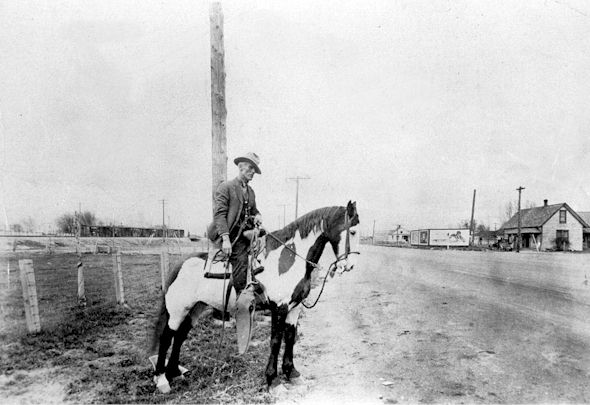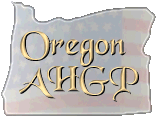Early Haines as I Remember
Early Haines As I Remember, Before 1912 to WW1 and Early '20's
By Orville Fisher
About the Author
Orville Fisher is an active farmer in the Rock Creek area. He, at 85 years of age, still puts in a full day on the ranch he runs with his son, Cecil. As a valley native he has a wealth of experience and memory to draw upon.
Orville Fisher 1901 - 1988
When younger, he followed rodeo and buckaroo as a way of life for many years.
He was marshal of the Haines, July 4 Stampede Parade over the 4th of July prior to 1980. He has served this area in many ways over the years.
Readers who have the Baker County History book could clip this article and include it in the book, friends of Mr. Fisher suggest, and they urged him to write this sketch for The Record-Courier.
Early Haines As I Remember, Before 1912 to WW1 and Early '20's
There were four stores: Haines Commercial,
Haines Mercantile, D.B. Womack's Dry Goods Store and Weaver Grocery. Also Ida
Young's Confectionary (she was Lonnie Young's mother), Durgan's Bakery and meat shop, which was first owned by Jake Jarman, then by Rozier and John Toney, later by Harry Bieber.
The Haines Commercial was originally owned by the "Three Johns," namely, John Christenson, John Ingram, and John Hammond. It was located north of the brick buildings. Lee Duncan bought it about 1905 and it became the Haines Commercial. My dad, Geo. A. Fisher was bookkeeper for the three Johns in the 1890's when the McCarty boys were trading there. He was well acquainted with them. Dad took the receipts from the two stores to the bank in Baker by rig. The McCarty's
had lived part time in a house where Dick Camp's store is now located.
The Haines Mercantile was originally the Wilcox. This was a farmer-owned store and was managed by Johnny O'Bryant. I can remember five saloons. First Young's, I don't recall his given name but he had a gentleman's place. He wouldn't stand for any roughhousing by the patrons. Then Hat Pearson, Berry Jolly and
Jess Toney. Charles Eilertson had a saloon but it burned earlier. Ed McCullough owned the Hat Pearson saloon at one time.
After the saloons went out,
Sam and Earl Hearing had a pool hall. They sold it to Louie DeLine who operated it for several years. He ran poker and blackjack games on Saturday nights. If you wanted big stakes you went upstairs. The original building burned in 1918 and he built the present pool hall building.
The bricks used in our present house built in 1919 were left over from the pool hall. Louie DeLong sold them to dad cheap
Lester and Ace Toney ran this pool hall for several years. Later, it changed hands several times including Ed Heard, George Loennig, George Duncan, Ben Pearson and others. Edna Ensminger Boyles sold to Neil Aldrich and he to Gordon Johnson. At the present time (1987) the business is closed.
There were two hotels and one rooming house. Mars owned the Oregon Hotel. Jake Jarman (Georgia Scott's grandmother). Later it was owned by a man named Tripp, then by John Lang, the a man named Steele. It was located north of the present red warehouse, west of the railroad. Mrs. Jarman served meals. She had a triangle gong on the porch, which she rang for the meals, breakfast, dinner and supper. The triangle could be heard all over town.
The Ben Toney Hotel was east of the Steak House in the middle of the block. Mrs. Sumerall had a rooming house where Sivan Calhoun's Baker Mill and Grain office is now. Toney's restaurant was on the main street. Charles Swan owned this place later. Fred Bull had a restaurant in the Hat Pearson saloon after the state went dry. Charles Swan was Haines Marshall in the early 1920's. He rode a big pinto horse around town keeping order. When a boy in the 1890's, he lived
with the McCarty's. He left town and was gone for several years before returning.
|
|
|
Charles Swan, City Marshall |
Livery Stables
There were two livery stables: The Red Front which was close to the Oregon Hotel and the "Feed and Living Stable, proprietor Albert Hornbeck," on the east side. It was probably first owned by
Ben and Lester Toney.
Ollie Robertson's freight barns were where the grange hall was developed after WWII, and Lonnie Fidler's barns were where the John Henner house is. These were big barns; freighting was a big business. Hitching racks were on both sides of the three streets running east and west of the main street.
There were three blacksmith shops, Bill Bell's located south of Baker Mill and Grain near the cement building; Charles Hoberg, where the Myers Garage building is (formerly Howden's, then Henner's, then Bahler's); and Scrivner and Cook where the Bahler home stands.
The famous white board-front Twilight Theater was located where Jan's Beauty shop is located. The Theater was torn down in 1966.
The first drug store that I remember was owned by N.E. Dodd and Vic Devall.
In 1904 when Dad started carrying the mail the post office was in the old mercantile store. Johnny O'Bryant was postmaster. Later the office was in the drug store, then on 3rd street in quarters behind the corner restaurant on the main (front) street. Frank Caston was Postmaster in the Republican years into the early 1930s.
The first telephone company was former owned and in the Haines Mercantile building. Then Vic Devall had it in the Three John's store. He sold the company to my uncle, Walter Heard, then on the
H.O. Wiswell, then to Vance Dix and then to the present owners, Cascade Utilities. The first operators that I remember were Mable and Mildred Toney.
Tom Parker had a pool hall and sporting goods store here in the early 1900s.
W.D. Nelson established the Haines Record in 1901 on the corner north of the Odd Fellows hall. The newspaper plant and office burned in 1926. The paper was purchased in 1928 by Charles and Elizabeth Brinton's as publishers and Byron became editor and was published as The Record-Courier. It continues now, with sons joining him.
The Bank of Haines was started in 1912 by John Toney, Henry Fisher, Frank Loennig and Ben Harder. The bank eventually moved to the county seat in 1934.
The Thomas Murtha Grocery store was opened in the early years of the century. It was sold to Del Hall who operated it for many years then changed hands several times and is now closed.
Stock Yards
The original stockyards were on the east side of the railroad tracks near the south crossing. It was then moved to the northwest side of town.
Ed Coles installed the scales and shipped from 1 to 104 carloads of cattle
and hogs to the Portland market every week for many, many years.
The Jim Mitchell lumberyard and planer mill was located where the old Gillette service station was located. It was sold to Riordons about World War I.
The first creamery was just south of the Joe Henner House (Tom Duncan place) on Rock Creek west of the railroad track. It closed and later Lonnie Young had a creamery station in the east of town.
The first baseball park was on the west side and here the first stampedes were held. The present Stampede grounds were built on the John Christensen property in 1922.
There was a large grandstand and race track. Louie LeLine, Ernie (Wamp) Hearing, John Christensen, Jr., Elmer Simon and Albert
Fisher were the principal boosters. All of we young guys did a lot of donation labor during the years.
I remember Dr. Francis. He was a big jolly fellow and pulled my first tooth. Dad was with me and I yelled "Kill him, Kill him," Doctor always laughed about that.
Dr. Roger Biswell, Sr. practiced in Haines for several years. There was another doctor for a while then Dr. C.D. Houser from the late 20s till moving to Baker. There was also a dentist, Dr. Hall, for a short time in the mid-20's.
Churches Built
There were three Churches, the
Baptist on the east side, Methodists on the west and a Catholic church
which was later moved to the country where is was used as a barn.
Barber shops: By a man named Page who sold to Dewey Burton, later owned by a Mr. Critchfield. Tom Smith, a colorful character, who claimed to have been with Teddy Roosevelt at San Juan Hill and we often heard about it. He entertained with tall tales of his experiences. He had one of the first flush toilets on the main street of Haines. He said "All the people keep coming in here to use my Sanitarium toilet.
They had one son, Buster, and one day when his mother was taking a bath he got out in the street. There was a run away team dashing down the street. Mrs. Smith dashed out of the home. Tom later said, "Mom as naked as a Jaybird and the prettiest damn sight you ever saw.
Jess and Albert Heard had a lunch counter and card room where the Fred Bull restaurant was. Ray and Norva Pullen operated it for many years. It is now the Steak House.
Clyde Siman had a shoe repair and saddle shop north of the Oregon Hotel. It was a gathering place for the livestock.
Haines was known as the Biggest Little Town in Oregon during the teens and twenties. It was a big shipping point for cattle ship, hogs and horses. Ed Cole was the major shipper. Later it was Coles and Charles Duby, the Coles and N. E. Dodd for several years. Others who shipped livestock were principally Billy Green, Charles McCullough, D. M. Cartmill and others. Lee Duncan of Haines Commercial shipped thousands of tons of hay each year. There was not much grain
until World War I and after.
A popular rhyme was:
Toney's town
Wilcox treat
Gilkey's restaurant
And nothing to eat.

